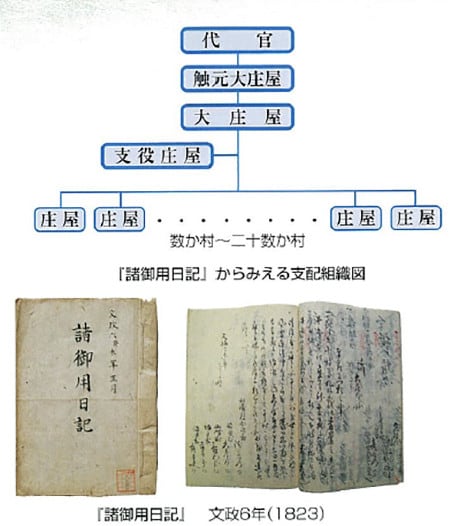



姫路藩というのは大阪・京都にもほど近く、明治以降開港した神戸が勃興する以前は国内統治の要衝地として、ながく徳川幕府時代には親藩・譜代大名が統治していた。
有名な姫路城を建築した池田氏も、小田原合戦で滅んだ北条氏に嫁いでいた徳川家康の娘が再嫁した家であり、その当時は50万石超を有する大大名。その連枝も近隣中国地域に領地を持っていて、それらを合計すると100万石を超えていたとされている。
そういう枢要の地で旧英賀城の敗残勢力で武力を放棄して経済家として蟠踞していた三木氏勢力は、1655年にこの神埼郡福崎町一帯の地域開発事業、新田開発事業を委任された。自らの「投資活動」によって新天地を開発してその支配を「大庄屋」として受注していたというカタチだろうか。
同様の三木家勢力としては、姫路市林田町の「林田三木家」大庄屋という存在もある。鉢植え的な大名側としては地域支配について、こういった勢力を活用して支配構造を作っていくのがスジというもの。
そして江戸期を通じて、幕政というのはほぼ前例主義で貫徹しているので、比較的に豊かな兵庫県地域では安定した支配構造が継続していたといえるのだろう。この福崎三木家は辻川組といわれる22ヶ村を中心にそのほか近隣の村々を統治する役割を担ってきている。その間、大きな土木事業として治水事業を成功に導いたりしている。ちょうど幕末期の関東での間宮林蔵の事跡とも共通する。
地域の行財政・治安・司法にいたる地方支配の権限を持つ存在である大庄屋。その役務とは、
1 藩からの命令を村々に伝達する。
2 各村から藩宛の願書や届けの取次業務
3 支配下の村々からの年貢米徴収や役務の割り当て
4 水利土木普請の資材・人材調達・指揮監督
5 村々の治安維持・取り締まり
6 争論・訴訟の調停
という広範な領域にわたっている。事実上、大名という鉢植え転地していく存在以上に、地域支配構造そのものを預かっていた存在だといえるのでしょう。
この姫路藩、兵庫県地域は幕府中枢の親藩支配地域であり、この福崎三木家がながく存続してきたのには、民衆との軋轢が比較的おだやかであったという事情もあったのかも知れません。同様の三木氏勢力で中国地方に移動していった系統では、同様の立場になったけれど、苛烈な年貢取り立ての仲介者としてしばしば怨嗟の対象にさせられてしまう事例もありました。
江戸という時代の閉鎖社会的性格が家系の歴史事情に刻み込まれていると思われますね。
English version⬇
The main body responsible for the economy and public works of the Himeji Clan Hyogo Fukusaki Miki Family Residence-5
This family lineage embodied the land rule that was the basis of the economic structure until the Edo period. The Himeji Clan and Hyogo Prefecture were key locations, and a stable society continued under the rule of powerful clans. The MIKI family's land and
The Himeji domain is located close to Osaka and Kyoto, and before Kobe, which opened its port after the Meiji period, was a strategic point for domestic governance.
The Ikeda clan, which built the famous Himeji Castle, was the daughter of Tokugawa Ieyasu, who had married into the Hojo clan, which was destroyed in the Battle of Odawara, and then remarried into the Ikeda clan, a feudal lord with over 500,000 koku at that time. The family also had fiefs in neighboring China, and the total of these was said to have exceeded 1 million koku.
In 1655, the Miki clan, the defeated remnants of the former Eiga Castle, which had abandoned military power and coiled itself as an economist, was entrusted with a regional development project in the Fukusaki Town area of Kanzaki-gun, Kanzaki-gun, and a shinden development project. The Miki family was entrusted with the development of new rice paddies in this area of Fukusaki Town, Kanzaki-gun, in 1655.
A similar Miki family power is the "Hayashida Miki Family" Taishoyaya of Hayashida-cho, Himeji City. It is natural for a potted feudal lord to utilize these forces to establish a structure of control over the region.
And since the shogunate was almost entirely based on precedent during the Edo period, it can be said that a stable ruling structure continued to exist in the comparatively affluent areas of Hyogo Prefecture. The Fukusaki Miki family has been responsible for governing 22 villages, known as the Tsujigawa clan, as well as other neighboring villages. During this time, they led a successful flood control project as a major civil engineering project. This is similar to the experience of Rinzo Mamiya in the Kanto region at the end of the Edo period.
The daimyo-ya are the authority that governs the local area, including administration of finances, public order, and the judiciary. What are his duties?
1. To transmit orders from the clan to the villages.
2. To act as an intermediary for applications and notifications from each village to the clan.
3. Collecting tribute from the villages under his control and assigning services to them
4 Procurement of materials and personnel for hydraulic and civil engineering projects, and direction and supervision
5 Maintenance of public order and policing of villages
6. Mediation of disputes and lawsuits
In effect, the Daimyo were potted plants. In effect, the Himeji clan was more than just a potted plant and a transplant called a feudal lord; it was also in charge of the regional ruling structure itself.
The Himeji and Hyogo areas were under the control of the Shogunate's central parent clan, and the Fukusaki Miki family's long existence may have been due in part to the fact that conflicts with the populace were relatively mild. Similar Miki clans that moved to the Chugoku region were in a similar position, but were often the target of vindictive behavior as intermediaries for the harsh collection of tribute.
It seems that the closed social character of the Edo period is imprinted in the historical circumstances of the family lineage.



















